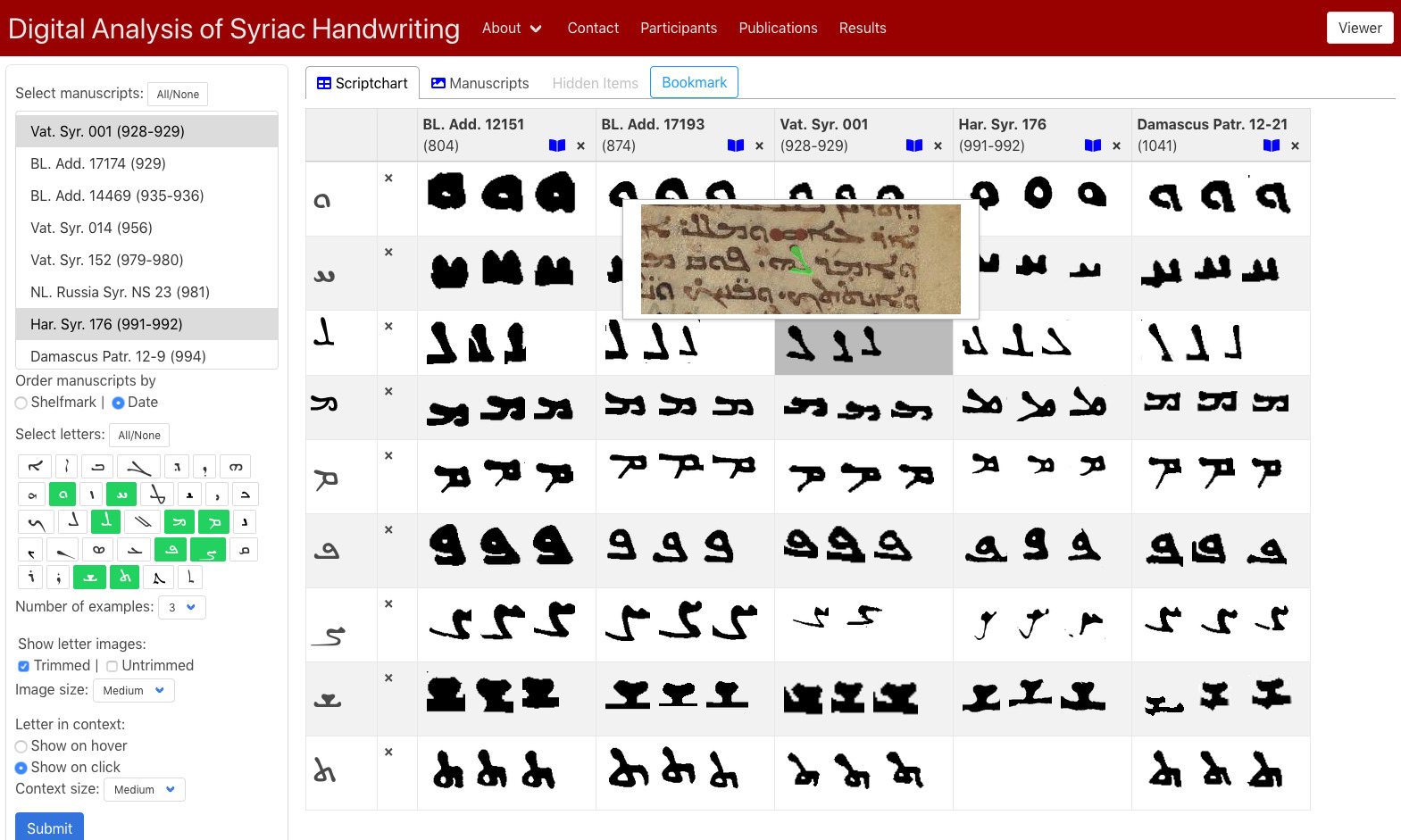1. Abstract
The DASH digital paleography project uses ancient manuscripts written in the Aramaic dialect of Syriac as a case study for exploring how recent advances in the digital analysis of handwriting can help scholars better ascertain a manuscript’s provenance, identify manuscripts written by the same scribe, and trace out the chronological development of ancient scripts.
At the core of the project is a curated manuscript database of metadata records describing 154 early, securely dated Syriac manuscripts, 1,432 digitized page images from these manuscripts, and the on-page coordinates of 67,242 individually identified letter images. An administrative interface with accompanying curation scripts enables project participants to manage data about the manuscripts and letter examples, and allows investigators to identify new letter examples.
 Fig. 1: The DASH interactive scriptchart app, displaying the letter-in-context feature
Fig. 1: The DASH interactive scriptchart app, displaying the letter-in-context feature
The interactive online manuscript viewer and customizable scripchart generator developed for this project (accessible at dash.stanford.edu) enables scholars to select any or all of the available manuscripts and Syriac letter forms for inclusion in a dynamically generated scriptchart. The scriptchart interface provides options to display up to the top five most highly rated instances of each selected letter on each manuscript at multiple zoom levels, and to view the letters in an excerpted, binarized form or highlighted within their original context on the manuscript page, with a variably sized context window around each letter instance to allow examination of its connections to neighboring letters. The chart facilitates dynamic reordering and hiding of manuscript columns and letter rows, providing scholars with an efficient means to propose and evaluate alternative localizations and chronologies for letter forms and manuscripts. In addition, the interface includes a URL-based bookmark function so that a researcher can easily share a particular scriptchart configuration with others.
The project source code is freely available on Github, and data regarding the coordinates of the identified letters on specific manuscript pages are available via an API endpoint. By agreement with the manuscripts’ host institutions, the interface also makes all manuscripts available for multi-up, zoomable viewing and navigation via embedded Mirador viewers that receive high-resolution images from the hosts’ servers using the International Image Interoperability Framework (IIIF).
 Fig. 2: Browsing multiple manuscripts in the DASH IIIF viewer
Fig. 2: Browsing multiple manuscripts in the DASH IIIF viewer
The database and interactive scriptcharts have facilitated studies of manuscripts that employ multiple classes of letters, with results that strongly suggest that the most typical way of classifying Syriac script as either exclusively Estrangela or Serto does not work particularly well for early manuscripts. Researchers also found that Estrangela letter forms were used as a “prestige” script and the frequency of their use showed a strong correlation with the genre of a given manuscript.
Although the initial goal of the DASH project is to advance the understanding of Syriac Christianity, its larger contribution is providing a platform and a model for similar ventures in other languages such as Arabic, Greek, Hebrew, Latin, and Sanskrit -- thereby positioning it at the crossroads of digital paleography.
References
“Challenging the Estrangela / Serto Divide: Why the Standard Model of Syriac Scripts Just Doesn’t Work,” Hugoye: Journal of Syriac Studies 21.1 (2018): 43-80. Kristina Bush, Michael Penn, R. Jordan Crouser, Nicholas Howe, and Shuangxia Wu.
“The Early History of the Syriac Script: A Reassessment.” Journal of Semitic Studies 45.1 (2000): 55–67. J. F. Healey.
“Speculative Practices: Utilizing Infovis to Explore Untapped Literary Collections.” IEEE Transactions on Visualization And Computer Graphics 22.1 (2016): 429–438. U. Hinrichs, S. Forlini, and B. Moynihan.
“The ‘Emergency’ Olaph: How Big Data About Little Things Changes Our View of Ancient Scribes” (in process). Michael Penn, Shuangxia Wu, Kristina Bush, R. Jordan Crouser, and Nicholas Howe.